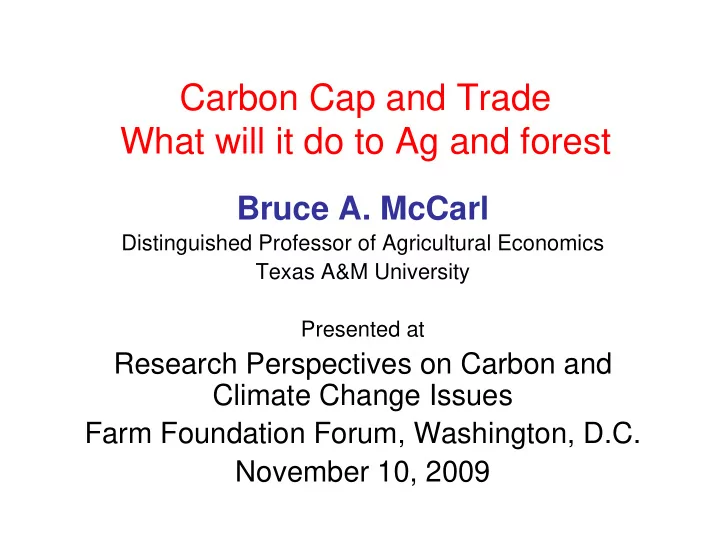

Carbon Cap and Trade What will it do to Ag and forest Bruce A. McCarl Distinguished Professor of Agricultural Economics Texas A&M University Presented at Research Perspectives on Carbon and Climate Change Issues Farm Foundation Forum, Washington, D.C. November 10, 2009
Why Care About GHGs
Greenhouse Gasses Where we are Source http://ssca.usask.ca/2002conference/Bennett.htm Source : U.S. National Assessment Carbon Dioxide highly associated with climate change Policy around world working to limit emissions
Where we could go Size of Potential Emissions Atmosphere 800 PgC (2004) Biomass N. Gas Oil ~500 PgC ~260 PgC ~270 PgC Soils ~1,500 PgC Coal 5,000 to 8,000 PgC Unconventional Fossil Fuels 15,000 to 40,000 PgC Source Jae Edmonds, Joint Global Change Research Institute at the University of Maryland
Why Adapt - Inevitability Stabilization Global mean temp. Year CO2 Reduction in 2050 CO2 Year CO2 needs level increase emissions back emissions compared to peak (ppm CO 2 -eq) at equilibrium ( º C) at 2000 level to 2000 445 – 490 2.0 – 2.4 2000 - 2015 2000- 2030 -85 to -50 490 – 535 2.4 – 2.8 2000 - 2020 2000- 2040 -60 to -30 535 – 590 2.8 – 3.2 2010 - 2030 2020- 2060 -30 to +5 800 590 – 710 3.2 – 4.0 2020 - 2060 2050- 2100 +10 to +60 700 710 – 855 4.0 – 4.9 2050 - 2080 +25 to +85 600 855 – 1130 4.9 – 6.1 2060 - 2090 +90 to +140 500
Why Agriculture and Forestry
Greenhouse Gas Emissions Sources
Historical Emissions Estimates Sequestration may have the potential to alleviate somewhere in the neighborhood of 25% of the historical atmospheric greenhouse gas accumulation. Source: Apparently this was drawn from W. F. Ruddiman, 2001. Earth's Climate: Past and Future. W. H. Freeman and Sons, New York
Per-capita fossil-fuel CO 2 emissions, 2005 World emissions: 27 billion tons CO 2 AVERAGE TODAY STABILIZATION 1- Source: IEA WEO 2007 and Socolow presentation at Americas Climate Choices
Effects and Responses Cap and Trade
AG and FOREST MITIGATION OPTIONS AG and FOREST MITIGATION OPTIONS Strategy Basic Nature CO2 CH4 N2O Crop Mix Alteration Emis, Seq X X Crop Fertilization Alteration Emis, Seq X X **Crop Input Alteration Emission X X Crop Tillage Alteration Emission X X Grassland Conversion Sequestration X Irrigated /Dry land Mix Emission X X Biofuel Production Offset X X X Stocker/Feedlot mix Emission X Enteric fermentation Emission X Livestock Herd Size Emission X X Livestock System Change Emission X X Manure Management Emission X X Rice Acreage Emission X X X Afforestation (not today) Sequestration X Existing timberland Management Sequestration X Deforestation Emission X
“The Effects of Low-Carbon Policies on Net Farm Income” Duke/TAMU et al Modeling Effort WORKING PAPER* Justin S. Baker Bruce A. McCarl Brian C. Murray Steven K. Rose Ralph J. Alig Darius Adams Greg Latta Robert Beach Adam Daigneault *Results under review, please do not cite at this time. *Some results shared today are not included in this working paper
FROM EPA (2005) GREENHOUSE GAS MITIGATION POTENTIAL IN U.S. FORESTRY AND AGRICULTURE National Mitigation Cost Curve for Agriculture, Forestry, and Biofuel Offsets $50 Agricultural soil carbon sequestration $30 Forest management $/t CO2 $15 Fossil fuel mitigation from crop production Agricultural CH4 and N2O $5 mitigation Afforestation $1 Biofuel offsets 0 500 1,000 1,500 2,000 2,500 MMT CO2 reductions relative to baseline
Liquid Portfolio Composition Ag Only Biodiesel Cell Ethanol Grain/Sug Ethanol
Dissecting Welfare Gains Further (Full Eligibility Scenario) Preliminary results. Subject to change.
Direct and Indirect Revenue Flows (Full Eligibility Scenario) • Energy Input Cost Increases: • 1.4%, 2.30%, and 4.10% per acre
Will RFS make Land Use Change Happen Corn Prices with Different Policies 4.00 3.50 3.00 Corn Price 2.50 base 2.00 with rfs2 with rfs2 and clim bill 1.50 1.00 0.50 0.00 2000 2010 2020 2030 2040 2050 Year Prices in $2004 dollars Base shows diminishing prices as yield growth exceeds demand RFS2 Holds prices up until it hits max Q then overtaken by Yield growth Climate Bill holds up prices
Food Competition Figure 1: Ethanol Production and Capacity plus new construction 2001-2008 16000 14000 12000 Million gallons 10000 Production 8000 Capacity+Construction 6000 4000 2000 0 Figure 4 US Average Corn Price in $ per Bushel 9 0 1 2 3 4 5 6 7 8 9 0 0 0 0 0 0 0 0 0 9 0 0 0 0 0 0 0 0 0 1 2 2 2 2 2 2 2 2 2 Year Corn Price $/Bushel 6 5 4 3 2 1 0 1998 1999 2000 2001 2002 2003 2004 2005 2006 2007 2008 Similarly soybean oil prices have changed
Effects of Policies on the Table Ordinarily Red items regarded as carbon sequestration reducing Blue items regarded as carbon sequestration increasing Colors for numbers are relative to NO RFS2
Findings � GHG mitigation competitive with Current Production � Price implications are substantial � Ag and forest income will increase � Consumers will pay � Big opportunities Afforestation, Bio electricity, Ag soil management, Forest management, Fossil fuel use � Leakage/indirect land use is a factor need global accounting and more than what lifecycle does � GHG prices move us away from current ethanols
Recommend
More recommend